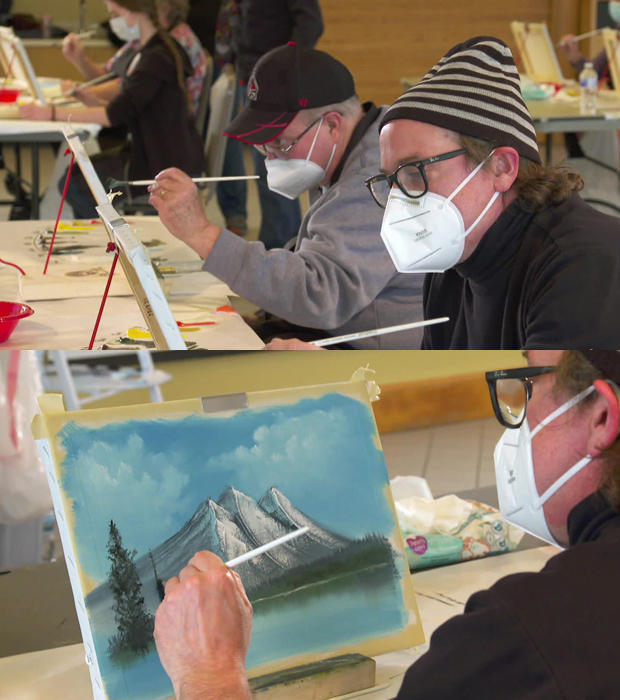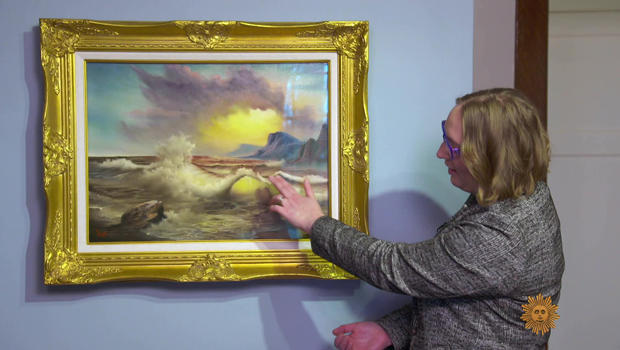The enduring popularity of artist Bob Ross
With his curious hair and his whisper of a voice, Bob Ross was perhaps an unlikely TV celebrity. But he became one of America's most famous painters – not only for his creativity, but for his positivity.
"We don't make mistakes; we have happy accidents," he told his audience.
It was like watching a magician reveal the secret of his trade.
"Look at that. Isn't that a nice little tree?"
But at the height of his fame, at only 52, Bob Ross died of lymphoma. That was 26 years ago. And yet, the "happy little painter" is perhaps more relevant now than ever.
"We've been in a time when things have been so frantic, and people have been so stressed, and Bob Ross is the King of Chill," said Jessica Jenkins.
But what many may not know is that when Ross came into our homes all those years ago, he did it from a home in Muncie, Indiana.
"Nobody really thinks about where the show was made," said correspondent Lee Cowan.
"So many people are surprised they walk in and they're like, 'This is not a TV studio, this is a living room!' Yeah, it's a living room!" laughed Jenkins, who is a curator of that living room – what is now the Bob Ross Experience at Muncie's Minnestrisa museum.
This very spot is where for years "The Joy of Painting" was taped. His paint brushes, his palette and, of course, his easel are here.
"Every episode he would have a moment where he would beat the devil out of the brush – he would take it and be just thump thump thump thump thump," said Jenkins. "People come in and they recognize that [spot where the brushes were beaten] and they know exactly what that is."
But why Muncie? Because this was the home of the local PBS station, WIPB. Traveling through the Midwest on a teaching tour, Ross approached the station with the idea of teaching in front of a camera.
Cowan said, "He was an unknown painter though at the time, I mean nobody knew who Bob Ross was."
"They did not know who he was, but he had a lot of charm," Jenkins said.
Jim Needham was WIPB's general manager, and he knew Ross had something. "His mantra was, 'I'll never do anything harder than my audience is able, also, to do.'"
"It really wasn't just about painting; the show was about a lot more than that," Cowan said.
Needham said, "I think the show was about giving a person agency, and doing what they want to do or something they were afraid to do. And I'm not talking about painting. I'm talking about life."
Ross practiced his TV paintings for days, making sure that he could complete them in front of the cameras in less than a half an hour. Jenkins said, "He was very planned out and very methodical."
"But it sure didn't come off that way," Cowan said. "It came off very spontaneous and calm. It wasn't like he was racing through it!"
"That's the thing about Bob: You know that on the inside he was on a speed clock getting through that painting, but on the outside he was just so relaxed, and made it look so easy."
Part of the Bob Ross Experience is trying your hand at painting. For certified Bob Ross instructor Doug Hallgren, the discovery that anyone can do it is the real joy of painting.
"Sometimes we grab their hand and say, 'It's going to be okay, we're going to do this together, just trust me on this,' and they're like, 'Oh, it worked!'" Hallgren said.
It was a remarkable ego boost for everyone here. One young guest, Elia, said, "After sitting down and painting a painting, I really believe I could do anything!"
Ross' simplicity, though, often brought criticism. The art world had mixed reviews of him, said Jenkins: "There were certainly a lot of people who categorized him at kitsch art. But if you look at the canvasses that Bob did on his own time for himself, they are complex."
Like this elaborate seascape that hung in his own home:
Hallgren said, "The later he got on in years, those paintings just got sharper and sharper and sharper."
Ross rarely made a dime off any of his paintings, and never expected any of his works to ever hang in a museum. But recently the Smithsonian acquired four Bob Ross paintings to add to its permanent collection.
In that, at least, the man who just wanted to paint a happy little world has cemented his place in it as well.
Jenkins said, "The message of having self-confidence, of trying new things – that doesn't get old. And because of that, I think that it just continues to resonate for generation after generation."
For more info:
Story produced by Jon Carras. Editor: Carol Ross.








